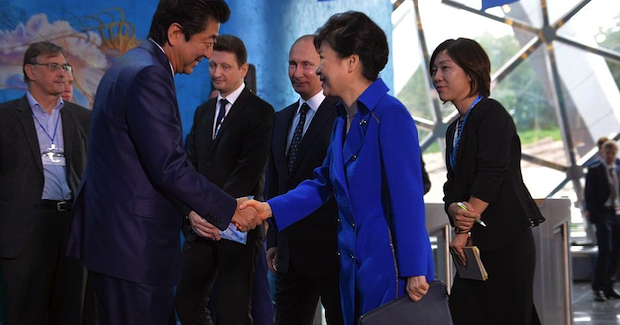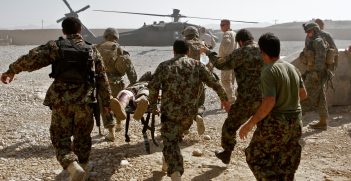Japan and South Korea Draw Closer

After a four-year hiatus, Japan and South Korea have finally signed a pact to directly share military intelligence on North Korea. Previously, they shared the same intelligence through the United States via a triangular memorandum of understanding, built on the existing hub-and-spokes alliance structure. This new arrangement, the General Security of Military Information Agreement, draws the final line of the triangle between the three countries.
Under the agreement, South Korea will provide valuable human intelligence and contextual analysis while Japan reciprocates with considerable satellite-based signals and surveillance intelligence.
Is this the start of a new balance of powers in Asia?
Of course not. From the Japanese perspective, the General Security of Military Information Agreement (GSOMIA) is the continuation of deliberate efforts by Prime Minister Shinzo Abe to deepen security ties across the region. The agreement with South Korea augments deepening ties with other regional states including India, the US, Russia, Indonesia, Malaysia, the Philippines and Vietnam. Japan is also deepening security ties with ASEAN nations more generally, through defence initiatives such as the ‘Vientiane Vision’. Combined with constitutional revisionism enabling broader military deployment, Abe is positioning Japan to be a major security actor in the region.
On the South Korean side, the long-awaited agreement is consistent with the hardline stance that President Park Geun-hye has taken against North Korea during her presidency. This stance has involved actively undermining North Korean relationships in Africa and Iran, and successfully agitating for further sanctions. She has also restarted counter-propaganda broadcasts and abandoned the joint Kaesong industrial complex, which was previously a symbol of North-South cooperation.
Whether or not it was encouraged by the US, GSOMIA builds upon improving relations between Japan and South Korea. Negative social relations between the two nations endure, rooted in decades of Japanese colonialism in the 1900s, and Japan’s use of South Korean ‘comfort women’ in World War II. However these societal wounds are mending, especially since a 1 billion yen (A$11.6 million) deal was signed in 2015 to resolve the comfort women dispute.
One of the greatest advantages to an intelligence-sharing pact is that it is a subtler way to meaningfully deepen a security relationship in an openly contested region. Yet China is still (understandably) worried about the ramifications of the GSOMIA. Even on an issue of joint concern, China sees improved security ties between two of its closest competitors as contrary to its interests. Politically, China has also never forgiven Japan for its actions in the lead-up to and during WWII, and Beijing does not respond well to any arrangements that improve Japanese military or diplomatic influence.
But why should Australians care about the GSOMIA? Well, if current trends continue there are opportunities for Australia to reap the benefits of an evolving security infrastructure in the Asia-Pacific. Further, Australia is drafting its first foreign policy White Paper since 2003 and security relationships are a crucial part of any diplomatic strategy.
The current landscape in the region is a confusing patchwork of consensus-based forums and bilateral agreements. But there are increasingly strong non-Chinese, non-US -related security ties developing in the region.
Norm-building forums such as ASEAN, and the relationships developed within, are the foundations upon which security dialogues (arguably) are being built. But to positively grow the security of the region, it cannot build only foundations and engage in dialogue forever. In any increasingly crowded space, it is much more efficient and cost-effective to build upwards on existing foundations, not outwards.
This is already happening. GSOMIA is an example of two nations building upwards from the existing foundations in the region. Although the agreement only focuses on one security issue, it provides a lower risk profile concerning North Korean military issues for Japan and South Korea. Pooling resources in this way benefits the entire region, as it frees up resources to be spent on other security challenges.
However, building upwards does not mean building inwards, to the exclusion of other nations. In fact, an additional way to build upwards is to share developed security arrangements with like-minded countries. Signing on to a proven program is often much more attractive than being a first-adopter.
The construction happening right now will frame international relations for decades to come. What will the next floor in the Asia-Pacific’s regional security order look like? Probably a less ambiguous one as countries work collectively to minimise security risks. The result is a benefit to regional powers, including sea trade-dependent Australia, as less ambiguity in a politically complex region leads to better-informed decision-making in a crisis. Expanding existing agreements upwards also enables more comprehensive risk mitigation of security issues prior to a crisis. Japan will likely play a central role in this architecture if it maintains its current pace of tying up deeper security agreements.
Australia is already located within the building site, and can be actively involved in the construction of the future order. As a hub-and-spokes alliance partner, Australia is ideally placed to join several low-commitment, high-reward security arrangements that already exist.
On GSOMIA specifically, Australia has long been a strong voice in the international community on WMD counter-proliferation and nuclear controls, commensurate with its responsibilities as a major uranium exporter.
Australia also shares a deep security relationship with Japan—a relationship described by Japan as second only to the US. The Japanese government was a prime contender in the 2016 Australian submarine tender. Australia and Japan already have their own trilateral strategic dialogue with the US, through which a military information-sharing agreement was recently signed. Australia has a similarly strong relationship with South Korea, and all three nations are like-minded liberal democracies with wider shared interests in the region.
The last few years have seen a deepening of regional defence relationships. This shows no sign of slowing— especially if Japan continues to lead, which is likely given Abe commands a parliamentary supermajority and has another two years in office.
Various elections in 2016 have done nothing to allay concerns about Asia-Pacific flashpoints. Consequently, it is in Australia’s interest—now more than ever—to find opportunities to improve its influence in the construction of the region’s future security architecture.
Tom Murphy is a public sector advisor specialising in Asia-Pacific security, and is the Australia Program Manager of the Washington-based Stratcon Initiative. He is a member of the AIIA’s ACT Branch. The views and opinions expressed in this article are those of the author and do not reflect the position of any other organisation or employer.
This article is published under a Creative Commons Licence and may be republished with attribution.





